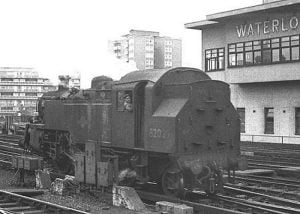Our Project Information this week will be exploring the short history (like most of the BR Standards) of the British Railway's (BR) Standard 3 Tanks.
The 46th member of the class is under construction at the Severn Valley Railway (SVR). We will look into the brief operation of these locomotives under BR. Along with the aims, the background of The 82045 Steam Locomotive Trust, and the progress made to date on building 82045.
History of the BR Standard 3 Tanks

As with all the BR Standards, Ex-London, Midland and Scottish Railway (LMS) designs influenced heavily in the drawing of BR's 12 new classes. Much of the chassis design followed closely to that on Ivatt's Class 2 locomotives. Other standard LMS components were also incorporated into their design. The boiler proved to be a problem when following LMS practices, with a Great Western Railway (GWR) design being chosen. The boiler used in the Standard 3 tank was adapted from the Swindon No. 2 boiler, used on many GWR Tanks. The main difference being a shorter boiler barrel on the Standard 3 tanks. The construction of the class was handed to Swindon Works, where all 45 locomotives were built.
The class had been planned to be 63 engines strong, but with the 1955 modernisation plan, the order was cancelled swiftly.
Performance in Service
Being built at Swindon Works in the Western Region (WR), many of the class were allocated to the WR, where they hauled secondary and branch line duties. They replaced older GWR tanks of the 45XX and 55XX classes, which after WR crews got used to them, proved to be suitable successors.
The class was also allocated to the North Eastern, London Midland and Southern Regions. All these regions seemed to like the Standard 3 Tanks, with the Southern Region being host to one of the best and last performances of the class. No. 82029, whilst on station pilot duties, had to take over from a failed engine on a passenger train. 82029 hauled only a short distance with the train before being taken off at Basingstoke. At Basingstoke, a more suitable replacement was found. Soon after being taken off the Train, 82029 was then withdrawn, making its stand-in on the passenger train its last duty for BR.
Decline and Withdrawal
The secondary and branch line work was the first to go with the introduction of diesel multiple units and Beeching's cuts. This left the Standard 3 Tanks, with plenty of life in them, with less and less work. 1964 saw the first 10 engines to be withdrawn. Two locomotives lasted until 1967, where they were withdrawn and cut up.
One of the final two hadn't been long in traffic since it's last overhaul, being in a very good condition. Enquires were made about purchasing the engine for preservation, the price was set at £1500 (around £25,000 in 2016). This being quite expensive and only a short amount of time to raise funds, the engine wasn't purchased and was sent for scrap.
The Aim and Background of The 82045 Steam Locomotive Trust
The project to build 82045 originated with John Besley, who decided a new engine, perfect for heritage lines, was needed. After drawing up a list of features the engine needed and feedback from a letter published in Steam Railway Magazine, John came to the conclusion that building the 46th member of the BR Standard 3 Tanks was the best option. The Project was officially launched in the late 1990's.
As stated above, the primary reason for 82045 construction is for heritage line running. The Project is based at the SVR, where most of 82045's building will take place. In return, 82045 will become apart of SVR's home fleet once completed. The SVR is also a good home for 82045 as the BR Standard 3 class would have run on the line in BR days. Where possible, the design of 82045 will follow the original Standard 3 Tank Plans.
Progress on Building 82045
The progress made on 82045's construction has been very good. Major components such as the smokebox, frame, cylinders, cab, and bunker have all been completed and fitted together at the SVR.
Recent work has seen the axle boxes for the centre driving wheels completed. This makes 82045 one step closer to becoming a rolling chassis. The water tanks are almost fully erected but require weatherproofing. Brackets for supporting the many cab fittings have been made, ready for when these fittings need installing. Vacuum pipework is also being fitted.
Many smaller components have been obtained since the start of the project, such as the chimney (from BR Standard 3 77014), set of buffers, various fittings for the cab to name a few items. Being a member of the British Railway Standard Locomotive Owners' Group (BRSLOG) has helped the trust obtain parts required and borrow patterns in order to make new parts.
We hope you have enjoyed this week's Project Information. Be sure to come back next Friday where we will be exploring our third new build Great Western locomotive.
- Visit the 82045 website
For more information